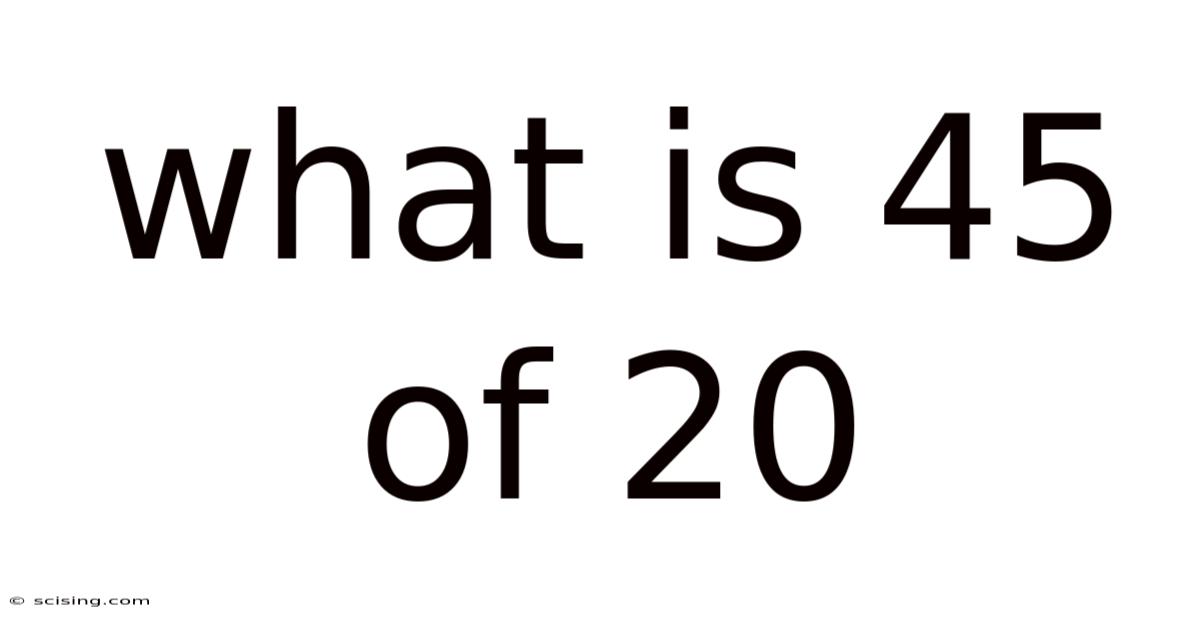What Is 45 Of 20
scising
Sep 06, 2025 · 4 min read

Table of Contents
What is 45% of 20? A Comprehensive Guide to Percentages and Calculations
Finding a percentage of a number is a fundamental skill in mathematics with applications spanning various fields, from everyday budgeting to complex financial analyses. This article will delve into the meaning of "What is 45% of 20?", explaining the process step-by-step, exploring different calculation methods, and offering insights into the broader concept of percentages. We'll also cover related calculations and frequently asked questions to provide a comprehensive understanding of this common mathematical problem.
Understanding Percentages
A percentage is a fraction or ratio expressed as a number out of 100. The symbol "%" represents "per cent," meaning "out of one hundred." For example, 45% means 45 out of 100, which can be written as the fraction 45/100 or the decimal 0.45. Understanding this fundamental concept is crucial for solving percentage problems.
Calculating 45% of 20: Method 1 - Using Fractions
The most straightforward method to calculate 45% of 20 involves converting the percentage to a fraction and then multiplying.
-
Convert the percentage to a fraction: 45% is equivalent to 45/100.
-
Multiply the fraction by the number: (45/100) * 20
-
Simplify the equation: We can simplify this by canceling out common factors. Both 20 and 100 are divisible by 20. This simplifies to (45/5) * 1 = 9
Therefore, 45% of 20 is 9.
Calculating 45% of 20: Method 2 - Using Decimals
Another common method uses decimal representation.
-
Convert the percentage to a decimal: 45% is equivalent to 0.45 (simply divide the percentage by 100).
-
Multiply the decimal by the number: 0.45 * 20 = 9
This method offers a more concise calculation, particularly when working with larger numbers or using a calculator. Again, the answer is 9.
Calculating 45% of 20: Method 3 - Proportion
This method uses the concept of proportion. We can set up a proportion to solve for the unknown value (x):
45/100 = x/20
To solve for x, we cross-multiply:
45 * 20 = 100 * x
900 = 100x
x = 900/100
x = 9
This method reinforces the underlying relationship between percentages and proportions, making it a valuable approach for understanding the concept. Once again, the result is 9.
The Importance of Understanding Percentage Calculations
The ability to calculate percentages is not limited to solving simple math problems. It's a vital skill in numerous real-world scenarios:
-
Financial Literacy: Calculating discounts, sales tax, interest rates, tips, and investment returns all involve percentage calculations. Understanding these calculations allows for informed financial decisions.
-
Data Analysis: Percentages are frequently used to represent data in graphs, charts, and reports. Understanding percentage changes, for example, is crucial for interpreting trends and making data-driven decisions.
-
Scientific Applications: Percentages are used extensively in various scientific fields, from chemistry (concentration of solutions) to biology (population growth rates).
-
Everyday Life: From calculating discounts at the store to understanding statistics presented in the news, percentage calculations are an essential part of daily life.
Expanding on Percentage Calculations: Further Examples
Let's explore a few variations to solidify understanding:
-
What is 20% of 45? Using any of the methods above (fraction, decimal, or proportion), the answer is 9. Notice that the numbers are reversed from our original problem, but the underlying mathematical relationship remains the same.
-
What is 110% of 20? This involves calculating a value greater than the original number. Using the decimal method: 1.10 * 20 = 22.
-
What percentage of 20 is 9? This is a reverse percentage calculation. We can set up a proportion: x/100 = 9/20. Solving for x, we get x = 45, confirming that 9 is 45% of 20.
Frequently Asked Questions (FAQ)
Q: What if I need to calculate a percentage of a number that isn't a whole number?
A: The same methods apply. For example, to find 45% of 20.5, you would simply multiply 0.45 by 20.5.
Q: How can I calculate percentages quickly without a calculator?
A: For simple percentages like 10%, 25%, or 50%, mental math is often sufficient. For more complex percentages, rounding the numbers can provide a quick estimate.
Q: Are there online calculators available for percentage calculations?
A: Yes, many free online calculators can perform percentage calculations efficiently. These are useful for complex calculations or for verification purposes.
Q: How do I calculate percentage increase or decrease?
A: Percentage increase/decrease is calculated as [(New Value - Old Value) / Old Value] * 100. A positive result indicates an increase, while a negative result indicates a decrease.
Conclusion
Calculating 45% of 20, which equals 9, is a relatively straightforward problem that illustrates the fundamental concepts of percentage calculations. Mastering this skill is crucial for various aspects of life, from everyday financial transactions to more complex mathematical and scientific applications. By understanding the different calculation methods – using fractions, decimals, or proportions – you can confidently tackle various percentage-related problems and make informed decisions in various contexts. Remember to practice regularly to improve your speed and accuracy in solving these types of problems. The more you practice, the more intuitive these calculations will become.
Latest Posts
Latest Posts
-
What Is Abab Rhyme Scheme
Sep 07, 2025
-
The Author Of The Necklace
Sep 07, 2025
-
Advantages Of A Sexual Reproduction
Sep 07, 2025
-
Northwest Passage Definition World History
Sep 07, 2025
-
El Lapiz In Plural Form
Sep 07, 2025
Related Post
Thank you for visiting our website which covers about What Is 45 Of 20 . We hope the information provided has been useful to you. Feel free to contact us if you have any questions or need further assistance. See you next time and don't miss to bookmark.